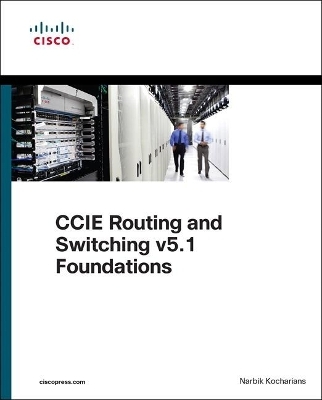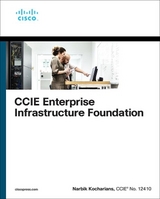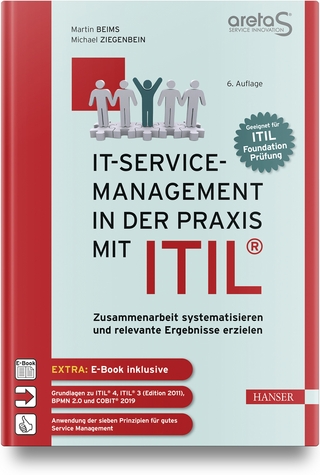
CCIE Routing and Switching v5.1 Foundations
Cisco Press (Verlag)
978-1-58714-472-1 (ISBN)
- Titel erscheint in neuer Auflage
- Artikel merken
Preparing for the CCIE Routing and Switching lab exam typically involves deep and lengthy study. But if you already possess the Cisco CCNP Routing and Switching certification, you already know much of what you’ll need to succeed on CCIE’s labs. This book will help you quickly bridge your remaining knowledge gaps and make the most of everything you already know.
CCIE Routing and Switching v5.1 Foundations addresses every segment of the CCIE R&S Version 5 blueprint, helping you focus your study where it will do the most good: intense hands-on practice to deepen your current knowledge and thorough explanations of theoretical topics you haven’t yet encountered.
Based on the author’s industry-recognized CCIE prep classes, it includes 40+ detailed labs for real gear and platform emulators; structured illustrations of protocol and feature operation; and topic-specific labs to drive the theory home. It includes a full lab walkthrough of a complex configuration reflective of the actual CCIE–ensuring that you thoroughly understand the technologies and interactions you’re reading about.
Discover the physical topology for any network deployment
Master Spanning Tree Protocol (STP) foundations and advanced features
Deploy and optimize PPP and use its full set of capabilities
Implement Dynamic Multipoint VPNs (DMVPNs) from start to finish
Use IP Prefix lists in prefix filtration, packet filtering, and other applications
Handle any RIPv2 deployment scenario n Implement EIGRP, including classical and named operation modes and interoperation
Use advanced OSPF techniques, including route filtration, LSA operation, stub configurations, and update filtering
Understand what happens when you perform redistribution, and manage problematic scenarios
Manage complex BGP capabilities, including Adjacency State Machine
Operate IPv6 in complex network environments, including DMVPN
Focus on QoS mechanisms that CCIE still covers, including traffic marking, classification, policing, and shaping
Deploy IPsec VPN solutions including GRE/IPSec tunnel mode, multi-site VPN technologies, and their encryption
Implement multicasting in environments requiring end-to-end IPv4 and IPv6 transport
Address operational and deployment issues involving MPLS VPNv4 tunnels
Narbik Kocharians, CCIE No. 12410 (Routing and Switching, Service Provider, and Security) is a triple CCIE with more than 40 years of experience in this industry. He has designed, implemented, and supported numerous enterprise networks. Narbik is the president of Micronics Networking and Training, Inc. (www.micronicstraining.com), where almost all Cisco authorized and custom courses are conducted, including CCIE-DC, CCIE-SP, CCIE-RS, CCIE-Security, and CCDE classes.
Introduction xxvii
Chapter 1 Physical Topology 1
Physical Layout of Switching Devices 1
Serial Interconnections Between Routers 3
Lab Options 5
Summary 5
Chapter 2 Physical and Logical Topologies 7
Topology Types 7
Lab 2-1: Introductory Lab 8
Lab 2-2: Physical-to-Logical Topology 18
Summary 33
Chapter 3 Spanning Tree Protocol 35
Lab 3-1: Basic Spanning Tree Protocol (802.1D) 35
Lab 3-2: Advanced Spanning Tree Protocol (802.1D) 50
Lab 3-3: Rapid Spanning Tree Protocol (802.1w) 73
802.1w Port States 74
802.1w Port Roles 74
Operational Enhancements of 802.1w 74
802.1w Rapid Convergence Mechanisms 75
Lab Setup 75
Lab 3-4: Multiple Spanning Tree Protocol (802.1s) 93
MST Regions 94
MST Region Components 94
MST Spanning Tree Instances 95
Multiple-Instance Spanning Tree Protocol (MSTP) 96
Lab 3-5: Spanning Tree PortFast 106
Lab 3-6: UplinkFast 115
Lab 3-7: BPDU Guard 128
Lab 3-8: BPDU Filter 135
Lab 3-9: Spanning Tree Backbone Fast 148
Lab 3-10: Spanning Tree Root Guard 154
Lab 3-11: Spanning Tree Loop Guard 162
Chapter 4 Point-to-Point Protocol 169
Introduction to PPP 169
PPP Frame Format 170
PPP Control Plane 171
Advanced PPP Features 179
Lab 4-1: PPP 182
Summary 218
Chapter 5 DMVPN 219
Lab 5-1: DMVPN Phase 1 Using Static Mapping 219
Lab 5-2: DMVPN Phase 1 Using Dynamic Mapping 229
Lab 5-3: DMVPN Phase 2 Using Static Mapping 236
Lab 5-4: DMVPN Phase 2 Using Dynamic Mapping 244
Lab 5-5: DMVPN Phase 3 251
Chapter 6 IP Prefix-List 267
Lab 6-1: Configuring Prefix Lists 267
Chapter 7 EIGRP 287
Lab 7-1: EIGRP 287
Lab 7-2: EIGRP Named Mode 311
Lab 7-3: EIGRP Metrics (Classic and Wide) 333
Lab 7-4: EIGRP Summarization 349
Lab 7-5: EIGRP Authentication 359
Lab 7-6: Default Route Injection 363
Lab 7-7: EIGRP Stub 368
Chapter 8 OSPF 381
Lab 8-1: Advertising Networks 381
Lab 8-2: OSPF Broadcast Networks 397
Lab 8-3: Non-Broadcast Networks 411
Lab 8-4: OSPF Point-to-Point Networks 421
Lab 8-5: OSPF Point-to-Multipoint and Point-to-Multipoint Non-Broadcast
Networks 425
Lab 8-6: OSPF Authentication 431
Lab 8-7: OSPF Summarization 462
Lab 8-8: OSPF Filtering 476
Lab 8-9: Virtual Links and GRE Tunnels 504
Lab 8-10: OSPF Stub, Totally Stubby, and NSSA Areas 517
Lab 8-11: How Is This Possible? 536
Lab 8-12: LSA Type 4 and Suppress FA 539
Lab 8-13: Can OSPF Take a Suboptimal Path? 549
Lab 8-14: RFC 3101 and RFC 1587 556
Chapter 9 Redistribution 567
Lab 9-1: Basic Redistribution 1 567
Lab 9-2: Basic Redistribution 2 586
Lab 9-3: Redistribute RIPv2 and EIGRP 604
Lab 9-4: Redistribute RIPv2 and OSPF 625
Chapter 10 Border Gateway Protocol 635
Lab 10-1: Establishing Neighbor Adjacencies 635
Lab 10-2: Router Reflectors 642
Lab 10-3: Conditional Advertisement and BGP Backdoor 650
Lab 10-4: Community Attribute 667
Lab 10-5: The AS-path Attribute 679
Lab 10-6: The Weight Attribute 686
Lab 10-7: Multi-Exit Discriminator Attribute 695
Lab 10-8: Filtering Using Access Lists and Prefix Lists 704
Lab 10-9: Regular Expressions 714
Lab 10-10: BGP Confederation 731
Chapter 11 IPv6 737
Lab 11-1: Acquiring an IPv6 Address 737
Modified EUI-64 Addressing 737
Using EUI-64 Addressing 738
Implement IPv6 Neighbor Discovery 739
Lab 11-2: Configuring OSPFv3 763
Lab 11-3: Summarization of Internal and External Networks 771
Lab 11-4: LSAs in OSPFv3 790
Lab 11-5: EIGRPv6 817
Chapter 12 Quality of Service 839
Lab 12-1: MLS QOS 840
Lab 12-2: Differential Service Code Point-Mutation 851
Lab 12-3: DSCP-COS Mapping 860
Lab 12-4: COS-DSCP Mapping 865
Lab 12-5: IP-Precedence-DSCP Mapping 870
Lab 12-6: Match Input-Interface and Match NOT 873
Lab 12-7: Match Destination and Source Address MAC 881
Lab 12-8: Match IP DSCP/Precedence vs. Match DSCP 885
Lab 12-9: Match Protocol HTTP URL, MIME, and Host 893
Lab 12-10: Class-Based Policing 898
Lab 12-11: Class-Based Shaping 907
Chapter 13 IPSec VPN 911
Lab 13-1: Basic Site-to-Site IPSec VPN 911
Lab 13-2: Basic Site-to-Site IPSec VPN and NAT 925
Lab 13-3: Configuring GRE/IPSec Tunnel Mode, Transport Mode, and S-VTI 930
Lab 13-4: Protecting DMVPN Tunnels 946
Chapter 14 Multicast 959
Lab 14-1: IGMP 959
Lab 14-2: Static RP 977
Lab 14-3: Dynamic Rendezvous Point Learning and Auto-RP 993
Lab 14-4: Bootstrap Router (BSR) 1013
Chapter 15 MPLS and L3VPNs 1025
Lab 15-1: Label Distribution Protocol 1026
Lab 15-2: RIPv2 Routing in a VPN 1078
Lab 15-3: EIGRP Routing in a VPN 1107
Lab 15-4: OSPF Routing in a VPN 1113
Lab 15-5: Backdoor Links and OSPF 1123
Lab 15-6: BGP Routing in a VPN 1148
Online element: Appendix A Configuration Files
9781587144721, TOC, 5/3/2017
| Erscheinungsdatum | 07.07.2017 |
|---|---|
| Verlagsort | Indianapolis |
| Sprache | englisch |
| Maße | 194 x 230 mm |
| Gewicht | 2080 g |
| Themenwelt | Informatik ► Weitere Themen ► Zertifizierung |
| ISBN-10 | 1-58714-472-7 / 1587144727 |
| ISBN-13 | 978-1-58714-472-1 / 9781587144721 |
| Zustand | Neuware |
| Haben Sie eine Frage zum Produkt? |
aus dem Bereich



